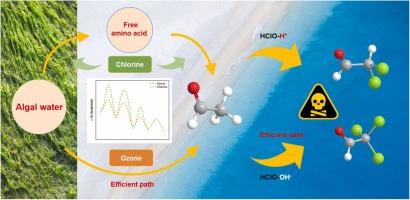Mechanistic Insights into Enhanced Haloacetaldehyde Formation from Algal Organic Matters after Pre-ozonation: A Combined Computational and Experimental Study
IF 12.2
1区 环境科学与生态学
Q1 ENGINEERING, ENVIRONMENTAL
引用次数: 0
Abstract
Pre-ozonation is widely used in the treatment of algae-containing water. Recent studies suggest that pre-ozonation could enhance the formation of haloacetaldehydes (HALs) but the mechanisms have not been clearly clarified. The study assessed the formation of dichloroacetaldehyde (DCAL) and trichloroacetaldehyde (TCAL) from model algal organic matters (Gly-Ala and Leu-Ala), and clarified the transformation mechanisms from the insight of quantum chemical computations. Results demonstrated a significant increase in HALs formation potential after pre-ozonation. When the dosage of O3 was 0.5 mg L-1, the formation of DCAL and TCAL increased 100% and 113% after chlorination, respectively. The initial pH of pre-ozonation was observed to be an important factor that influenced the HALs formation potential. The alkaline conditions promoted the formation of HALs, while acidic conditions have an inhibitory effect. Furthermore, the ultra-performance liquid chromatography high-resolution mass spectrometry (UPLC-HRMS) was applied to identify the transformation products of the pre-ozonation-chlorination process. Combined with quantum chemical computations, the transformation pathways of HALs were proposed. It was found that pre-ozonation promotes the formation of acetaldehyde, an intermediate during the formation of HALs. The initial pH plays an important role in the production of HALs, which influenced the reaction pathways and affected OH• formation. This study provides an in-depth analysis of the reaction mechanism and offers new theoretical insights for mitigating, controlling, and managing the risks associated with HALs.

求助全文
约1分钟内获得全文
求助全文
来源期刊

Journal of Hazardous Materials
工程技术-工程:环境
CiteScore
25.40
自引率
5.90%
发文量
3059
审稿时长
58 days
期刊介绍:
The Journal of Hazardous Materials serves as a global platform for promoting cutting-edge research in the field of Environmental Science and Engineering. Our publication features a wide range of articles, including full-length research papers, review articles, and perspectives, with the aim of enhancing our understanding of the dangers and risks associated with various materials concerning public health and the environment. It is important to note that the term "environmental contaminants" refers specifically to substances that pose hazardous effects through contamination, while excluding those that do not have such impacts on the environment or human health. Moreover, we emphasize the distinction between wastes and hazardous materials in order to provide further clarity on the scope of the journal. We have a keen interest in exploring specific compounds and microbial agents that have adverse effects on the environment.
 求助内容:
求助内容: 应助结果提醒方式:
应助结果提醒方式:


